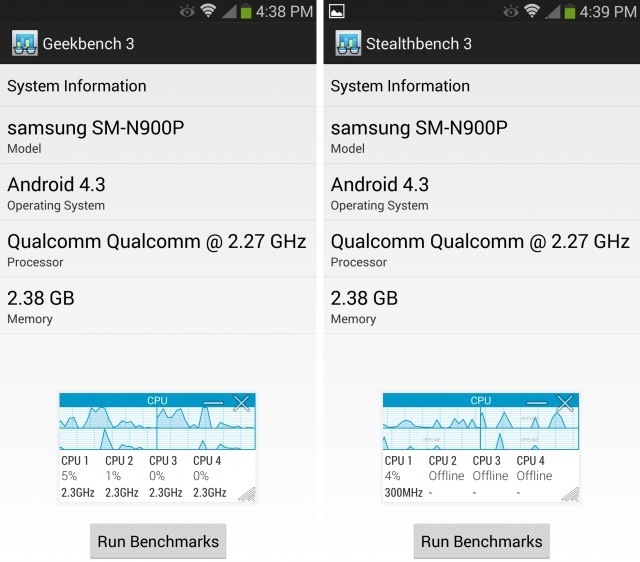Once again, Samsung inflates their numbers by artificial boosting their devices and going so far to as trick the applications running the tests to max itself out. Caught in the act again.

Above is a picture of Geekbench and of Stealthbench, which is identical to Geekbench in every way except for a different package name. With Geekbench, System Monitor shows the CPU is locked into 2.3 GHz mode and all cores are active, but in Stealthbench, the CPU is allowed to idle, shut off cores, and switch power modes, the same way it does in any other app. We have successfully disabled the special benchmark mode.
"Geekbench" is a popular benchmarking app, so the Note is programmed to give it special treatment. It has never heard of "Stealthbench," though, so despite being the exact same app, it does not get the special benchmark boost. The Note will run this benchmark like 99.99999 percent of the other apps on the device. The next step then, is to run the two benchmarks and compare the CPU's benchmark mode with non-benchmark mode.
The file we ended up with is called "DVFSHelper.java," and it contains a hard-coded list of every package that is affected by the special CPU boosting mode. According to this file, the function is used exclusively for benchmarks, and it seems to cover all the popular ones. There's Geekbench, Quadrant, Antutu, Linpack, GFXBench, and even some of Samsung's own benchmarks. The two functions applied to this list seem to be "PACKAGES_FOR_BOOST_ALL_ADJUSTMENT," which is no doubt the CPU booster, and "PACKAGES_FOR_LCD_FRAME_RATE_ADJUSTMENT," which makes it sound like the phone is also altering the display frame rate.
via Ars Technica













